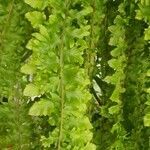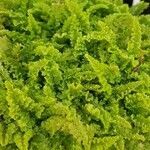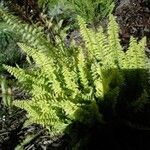Rhizome short, ascending, emitting long slender stolons, paleate; stipites tufted. Stipes stout, 7-25 cm. × c. 3 mm., brown, sparingly paleate; rhachis stout, us. with ∞ ovate-attenuate brown paleae and hairs. Lamina oblong-lanceolate, subcoriac., 25-60-(90) × 10-15-(20) cm. Pinnae close-set, ∞, patent; lowest reduced, us. sterile, up to 2 cm. × 1 cm., oblong, obtuse. Mid-pinnae up to 7 cm. × 15 mm., us. fertile, oblong to lanceolate-oblong, acute or acuminate to obtuse, auriculate at base; margins crenulate-dentate; veinlets close-set, forking near tips; uppermost pinnae rather abruptly diminishing to acute apex. Sori submarginal, globose, hardly exceeding 1 mm. diam., up to 70 per pinna. Indusium not completely covering sorus, firm, reniform.




